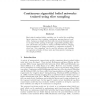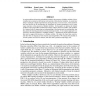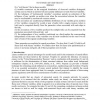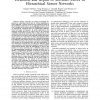CSDA
2007
14 years 7 months ago
2007
Model-based clustering exploits finite mixture models for detecting group in a data set. It provides a sound statistical framework which can address some important issues, such as...
BMCBI
2008
14 years 7 months ago
2008
Background: With the abundant information produced by microarray technology, various approaches have been proposed to infer transcriptional regulatory networks. However, few appro...
NIPS
1996
14 years 8 months ago
1996
Real-valued random hidden variables can be useful for modelling latent structure that explains correlations among observed variables. I propose a simple unit that adds zero-mean G...
NIPS
2000
14 years 8 months ago
2000
A serious problem in learning probabilistic models is the presence of hidden variables. These variables are not observed, yet interact with several of the observed variables. As s...
UAI
2004
14 years 8 months ago
2004
Based on a recent development in the area of error control coding, we introduce the notion of convolutional factor graphs (CFGs) as a new class of probabilistic graphical models. ...
UAI
2001
14 years 8 months ago
2001
A serious problem in learning probabilistic models is the presence of hidden variables. These variables are not observed, yet interact with several of the observed variables. Dete...
UAI
2001
14 years 8 months ago
2001
It is "well known" that in linear models: (1) testable constraints on the marginal distribution of observed variables distinguish certain cases in which an unobserved ca...
116
click to vote
SUTC
2006
IEEE
15 years 1 months ago
2006
IEEE
Abstract— Sensor networks are being increasingly deployed for collecting critical data in various applications. Once deployed, a sensor network may experience faults at the indiv...
PKDD
2009
Springer
15 years 1 months ago
2009
Springer
Abstract. This article presents a method for training Dynamic Factor Graphs (DFG) with continuous latent state variables. A DFG includes factors modeling joint probabilities betwee...




